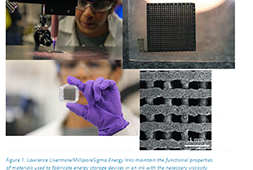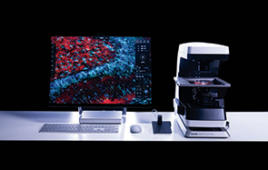.jpg)
A research team from the U.S. Department of Energy’s Lawrence Berkeley National Laboratory has developed a new way to 3D print all-liquid devices that could enable automated chemical synthesis with applications for batteries and drug formulation.
To achieve this, the researchers printed liquid containing nanoscale clay particles and liquid containing polymer particles onto a specially patterned glass substrate. This allows the liquids to come together at the interface of each other and form an extremely thin channel or tube about one millimeter in diameter within milliseconds.
After multiple channels form, the researchers placed catalysts in different channels and then 3D-printed bridges between channels to connect them and allow a chemical flowing through them to encounter catalysts in a specific order. This sets off a cascade of chemical reactions that can ultimately produce specific chemical compounds.
The researchers also found a way to automate the process with a computer to execute tasks associated with catalyst placement, build liquid bridges within the device and run reaction sequences required to make molecules.
“What we demonstrated is remarkable. Our 3D-printed device can be programmed to carry out multistep, complex chemical reactions on demand,” Brett Helms, a staff scientist in Berkeley Lab’s Materials Sciences Division and Molecular Foundry, who led the study, said in a statement. “What’s even more amazing is that this versatile platform can be reconfigured to efficiently and precisely combine molecules to form very specific products, such as organic battery materials.”
The study builds on 2018 research where scientists developed a new method to print various liquid structures within another liquid, including droplets and swirling threads of liquid.
“After that successful demonstration, a bunch of us got together to brainstorm on how we could use liquid printing to fabricate a functioning device,” Helms said. “Then it occurred to us: If we can print liquids in defined channels and flow contents through them without destroying them, then we could make useful fluidic devices for a wide range of applications, from new types of miniaturized chemical laboratories to even batteries and electronic devices.”
The new device can be programmed to function as an artificial circulatory system that separates molecules flowing through the channel, automatically removing unwanted byproducts all while printing a sequence of bridges to specific catalysts and carrying out the steps of chemical synthesis.
“The form and functions of these devices are only limited by the imagination of the researcher,” Helms said. “Autonomous synthesis is an emerging area of interest in the chemistry and materials communities, and our technique for 3D-printing devices for all-liquid flow chemistry could help to play an important role in establishing the field.”
To further improve their technology, the researchers are planning to electrify the walls using conductive nanoparticles, expanding the types of reactions that can be explored.
“With our technique, we think it should also be possible to create all-liquid circuitry, fuel cells, and even batteries,” Helms said. “It’s been really exciting for our team to combine fluidics and flow chemistry in a way that is both user-friendly and user-programmable.”
The study was published in Nature Communications.




